The Moon Io: Tidally Driven Active
Interior and Potmarked Surface
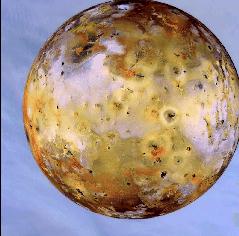 The adjacent figure
(Ref)
shows the best Galileo Orbiter image yet of
Io's full disk. How did this innermost of the Galilean
satellites come to look like a (moldy) pizza? The answer is that Io is the
most active object geologically in the Solar System. It is covered with
volcanic activity that spews various sulfur compounds onto the surface and
accounts for the color and pocked nature of the surface.
The adjacent figure
(Ref)
shows the best Galileo Orbiter image yet of
Io's full disk. How did this innermost of the Galilean
satellites come to look like a (moldy) pizza? The answer is that Io is the
most active object geologically in the Solar System. It is covered with
volcanic activity that spews various sulfur compounds onto the surface and
accounts for the color and pocked nature of the surface.
As we shall see, this
volcanic activity does not originate in plate tectonic activity
the way that much volcanic activity
originates on the Earth.
For Io, we shall see that instead it is
tidal forces
associated with nearby Jupiter.
The Volcanoes of Io
In 1979 an engineer responsible for navigation of the Voyager I spacecraft
noticed a strange mushroom-like object on the limb of Io, in an image of stars
used to check the positioning of the spacecraft. After ruling out trivial
explanations, it was realized that the camera had captured a volcano erupting
on the surface of Io, the first live volcano found in the Solar System beyond
the Earth. Subsequent spacecraft (Voyager II and Galileo) have documented
extensive vulcanism on the surface of Io, as illustrated in the following three
images.
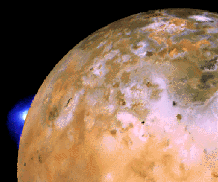 |
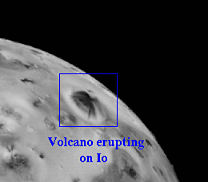 |
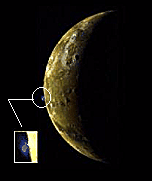 |
|
Volcano on Io's limb discovered by Voyager
(Ref)
|
Volcano erupting on Io as observed by Voyager
(Ref)
|
Galileo image
of volcano erupting on Io.
|
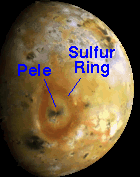 The rightmost image above is of the large shield volcano
Ra Patera, as recently photographed by the
Galileo spacecraft.
Some volcanoes
seen by Voyager are no longer erupting, but there are new volcanoes that have
begun erupting in the 17 years between Voyager and Galileo.
The rightmost image above is of the large shield volcano
Ra Patera, as recently photographed by the
Galileo spacecraft.
Some volcanoes
seen by Voyager are no longer erupting, but there are new volcanoes that have
begun erupting in the 17 years between Voyager and Galileo.
The
image adjacent left
shows the region near the volcano Pele, as photographed
by
Galileo in 1996.
The large red ring around Pele is thought to indicate recent
volcanic activity. The red
color indicates the presence of Sulfur, although how the Sulfur was produced is
not precisely known.
The Surface and Interior of Io
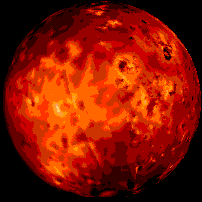 Indeed, we now know that Io has the youngest surface in the Solar System.
Present estimates are that it is so active geologically that its surface is
completely redone on a timescale of about a million years---a twinkling of the
eye on geological timescales. This makes Io the most active object
geologically in the Solar System. In addition to the intense volcanic activity,
Io's surface is being continuously eroded by a bombardment of charged particles
trapped in Jupiter's magnetic field.
Indeed, we now know that Io has the youngest surface in the Solar System.
Present estimates are that it is so active geologically that its surface is
completely redone on a timescale of about a million years---a twinkling of the
eye on geological timescales. This makes Io the most active object
geologically in the Solar System. In addition to the intense volcanic activity,
Io's surface is being continuously eroded by a bombardment of charged particles
trapped in Jupiter's magnetic field.
The source of this geological activity is
the
tidal effect of Jupiter on Io as it orbits the giant planet. These tidal
forces are so large that Io's surface is pulled upwards and downwards by
hundreds of meters in each rotation. Just like bending a paper clip heats it,
these tidal distortions keep much of the interior of Io in a molten state.
Thus, Io is a thin crust (primarily of sulfur) sitting on a molten interior.
It is this molten interior breaking through to the surface that produces the
volcanoes of Io, and the spectacular surface appearance as captured in the
adjacent animation (
Ref)) of a sequence of Hubble Space Telescope images.
The Io Torus and the Io Flux Tube
As we have already seen Io influences and is strongly influenced by Jupiter's
magnetic field. The moon orbits within the field, and material ejected from
its surface by volcanoes (and by the charged particle bombardment from the
material already trapped in Jupiter's magnetic field)
is a primary source of the charged particles
in the Jovian magnetic field. These particles (primarily sulfur and
oxygen) have a high
concentration in a doughnut shaped region surrounding Io's orbit called the Io
Torus.
Here is a movie simulating the
Io Plasma Torus.
As Io moves around its orbit in the strong magnetic field of Jupiter and
through this plasma torus, a huge electrical current is set up between Io and
Jupiter in a cylinder of highly concentrated magnetic flux called the
Io Flux Tube. The Flux Tube has a power output of about
2 trillion watts,
comparable to the amount of
all manmade power produced on Earth. It is responsible for bursts of
radio frequency radiation long detected on Earth.
A more detailed description is of the Io--Jupiter
relationship with diagram is:
here.
 The adjacent figure
(Ref)
shows the best Galileo Orbiter image yet of
Io's full disk. How did this innermost of the Galilean
satellites come to look like a (moldy) pizza? The answer is that Io is the
most active object geologically in the Solar System. It is covered with
volcanic activity that spews various sulfur compounds onto the surface and
accounts for the color and pocked nature of the surface.
The adjacent figure
(Ref)
shows the best Galileo Orbiter image yet of
Io's full disk. How did this innermost of the Galilean
satellites come to look like a (moldy) pizza? The answer is that Io is the
most active object geologically in the Solar System. It is covered with
volcanic activity that spews various sulfur compounds onto the surface and
accounts for the color and pocked nature of the surface.




 Indeed, we now know that Io has the youngest surface in the Solar System.
Present estimates are that it is so active geologically that its surface is
completely redone on a timescale of about a million years---a twinkling of the
eye on geological timescales. This makes Io the most active object
geologically in the Solar System. In addition to the intense volcanic activity,
Io's surface is being continuously eroded by a bombardment of charged particles
trapped in Jupiter's magnetic field.
Indeed, we now know that Io has the youngest surface in the Solar System.
Present estimates are that it is so active geologically that its surface is
completely redone on a timescale of about a million years---a twinkling of the
eye on geological timescales. This makes Io the most active object
geologically in the Solar System. In addition to the intense volcanic activity,
Io's surface is being continuously eroded by a bombardment of charged particles
trapped in Jupiter's magnetic field.